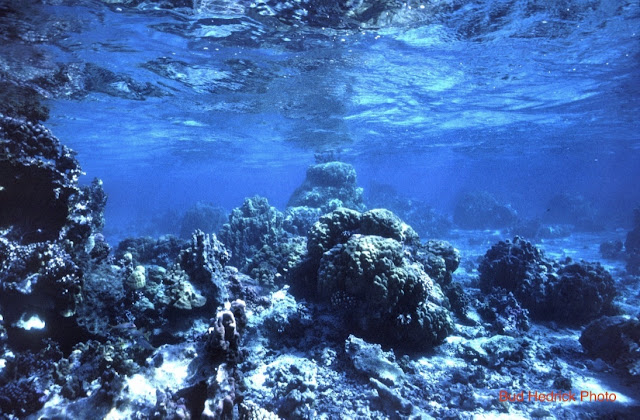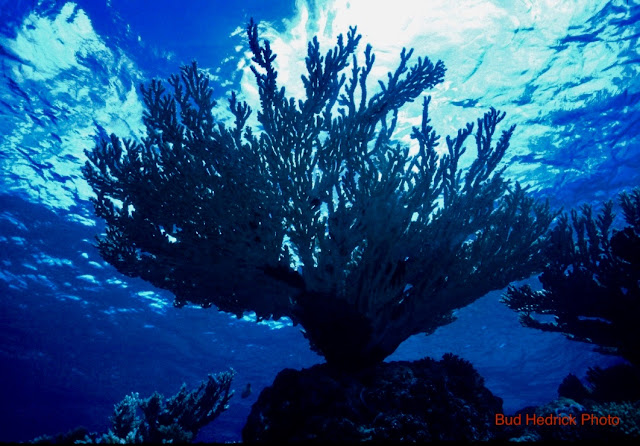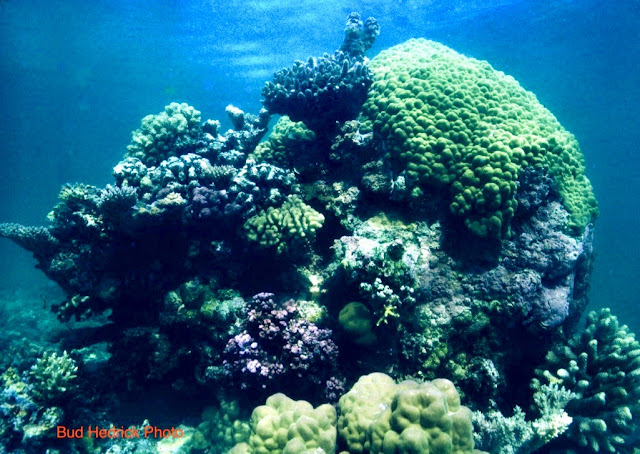An Undersea Forest of Coral
These photos were taken in French Polynesia in 1972, in the waters that encompass the islands of Raiatea and Tahaa. Two Tahitian islands that share a surrounding reef.
The town of Uteroa can be seen perched on the shore of the lower Island, Raiatea, and beyond the blue lagoon cloaked with clouds is the other island, Tahaa. The lagoon in between the two islands is where most of these coral formations were photographed. Later Casi, my spouse and model, and I dove outside the reef to get pictures of coral in the deeper water.
Being heliotropic these larger formations grow closer to the surface and are able to fan out and absorb more sunlight, while
those in deeper water experience slower growth and are shaped more like boulders.
Publications cataloging these different corals were not available in Tahiti making recognition of species difficult, although some of the coral heads could be distinguished because they were similar to those of Hawaii.
Schools
of little Tiger-striped fish patrol the corals.
Structures resembling sea fans
become proud sentinels.
An example of what is commonly called
brain coral. New polyps flourish upon
the old growth expanding the size of the formation as they develop.
Very similar to, if not the same as
Antler Coral, this species is seen throughout the tropical waters of the world.
Here we are outside the reef and in
deeper water where the types of corals differ in shape and color.
Here we see an example of polyps, how they grow in
layers and the shapes they form.
Close up of polyps,
of differing forms,
and shapes.
Again, we are outside of
the reef in deeper water where there is minimal sunlight. These small coral
boulders maturate slower here, but given time and the appropriate conditions, they will
become huge by growing layer after layer of fresh polyps on their previous
bones.
Now here is a boulder shape
of various corals and colors. Imagine the years it took to
develop to this size.
As one descends into the
depths the light dims and the blue hues darken. Without the strobe light there
is little color.
It is interesting
how coral sometimes forms in rows, but I was never able to ascertain whether it was
because of the current or a search for more sunlight.
We were never bothered with Reef Sharks in the still sheltered
waters, nor did we see sizable fish there. But in the passes where fish and boats
can get through the reef and into the open water outside of the lagoon,
one has to be on the lookout for sharks. Reef sharks tend to be territorial and
protective of their particular area. Also, we were warned not to eat
coral-eating fish like the Parrot fish or even fish such as Barracudas that eat coral-eaters. Barracudas caught in the open sea however were not consider a poisonous risk.
It was a mystery to me when
I started seeing underwater spider webs around the base of coral. Even now I
have never seen the spider but have learned it is known as the Diving Bell
Spider and is common in fresh water ponds and in salt water seas. In a study of the spider Argyroneta aquatica, Roger Seymour and Stefan
Hetz found that “each spider constructs a net of silk in vegetation beneath the
surface and fills it with air carried down on its abdomen. The spiders spend their entire
lives submerged and even lay their eggs in their diving bells.”
Seymour and Hetz, report that the spiders can use the diving bell like a
gill to extract oxygen from water and remain hidden beneath the surface. However,
despite satisfying the spider's oxygen demands, the bubble continually shrinks
because nitrogen diffuses back into the water, eventually forcing the occupant
to venture to the surface to resupply the diving bell. So how long could the
bubble survive before the spider had to dash up for air? Calculating the
diffusion rate of nitrogen out of the bubble, Seymour and Hetz were surprised
to find that the spiders could sit tight for more than a day. "The previous
literature suggested they had to come to the surface as often as every 20 minutes throughout the day,' comments Seymour, who adds, 'It is advantageous for the
spiders to stay still for so long without having to go to the surface to renew
the bubble, not only to protect themselves from predation but also so they
don't alert potential prey that come near." Read
more at ://phys.org/news/2011-06-bell-spider-spiders.html
Afterword:
“Why has it been so long
since you posted a blog?” I have been asked.
The last blog was, Spain
and the Bulls, and it attracted enough interest that several friends suggested
that it should be re-edited as a book. And so it was, but it took most of a
year to restructure into book form and then publish it. Now finished and
available at Amazon I have time to return to the blog and narrate other stories
and show photos. I hope you have enjoyed the trips and will follow along….And
please check out the new book, Spain and the Bulls. Thanks, Bud

































